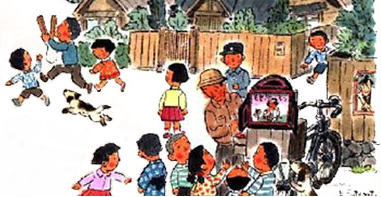|

|
KAMISHIBAI - A BRIEF HISTORY
By Tara McGowan
Kamishibai, (kah-mee-she-bye)
or “paper-theater,” is said to have started in Japan in
the late 1920s, but it is part of a long tradition of picture storytelling,
beginning as early as the 9 th or 10 th centuries when priests used
illustrated scrolls combined with narration to convey Buddhist doctrine
to lay audiences. Later, etoki (picture-tellers) adopted these
methods to tell more secular stories. Throughout the Edo period (1603-1867)
and on into the Meiji period (1868-1912), a variety of street performance
styles evolved, using pictures and narration.
The stages used for these early precursors
of kamishibai were  not
as easily transportable as the form that developed in the late 1920s
and came to be what we know as kamishibai today. The kamishibai performer
made a living by selling candy, and he could strap the small wooden
stage onto his bicycle with the illustrated cards and his wares and carry
them easily from town to town. Typically, the stories were told in serial
fashion and were so suspenseful that audiences came repeatedly to buy
candy and to hear the next episode of the story. not
as easily transportable as the form that developed in the late 1920s
and came to be what we know as kamishibai today. The kamishibai performer
made a living by selling candy, and he could strap the small wooden
stage onto his bicycle with the illustrated cards and his wares and carry
them easily from town to town. Typically, the stories were told in serial
fashion and were so suspenseful that audiences came repeatedly to buy
candy and to hear the next episode of the story.
Kamishibai is, if anything, poor-man’s
theater, and it flourished during a time when Japan experienced extreme
financial hardship. In the 1930s, Japan suffered from an economic depression
that sent many people onto the streets looking for a way to live from
one day to the next, and kamishibai offered an opportunity for artists
and storytellers to make a meager living. During and after World War
II, kamishibai became an ever more integral part of the society as a
form of entertainment that could be transported easily even into bomb-shelters
and devastated neighborhoods. At this time, it was entertainment as
much for adults as for children.
By the 1950s and the advent of television,
kamishibai had become so popular that television was initially referred
to as denki kamishibai, or “electric kamishibai.”
But as Japan became increasingly affluent, kamishibai became associated
with poverty and backwardness. Eventually kamishibai as a street-performance
art all but disappeared. The artists who had made their living with
kamishibai turned to more lucrative pursuits, notably the creation of
manga (comic books) and later anime, but they never
entirely forgot their roots in kamishibai. In fact, kamishibai is often
seen as a precursor of manga, and its influence can still be
felt in the distinguishing features of these later media.
But kamishibai has never entirely died
out. Kamishibai stories for educational purposes are still being published
and can be found in schools and libraries throughout Japan and more
recently, through the efforts of Kamishibai for Kids, in the
United States and Canada. There are many people, too, who, like Allen
Say, feel nostalgia for the old street-performances, and recreations
of these can be found at various outdoor events and festivals. A particularly
vibrant aspect of the kamishibai revival are the tezukuri kamishibai
(hand-made kamishibai) festivals held at designated points throughout
the year, where people young and old gather to perform kamishibai stories
they have illustrated themselves. There are Japanese kamishibai artists
who have taken their art form to other parts of Asia (Vietnam, Laos,
Cambodia, Thailand), where people are learning to make and perform their
own stories in their own languages. Kamishibai has become a way to bridge
cultural and linguistic barriers. Wherever there are people who want
to gather and share stories, kamishibai will always have a place.
|
|







